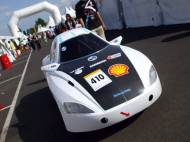SAHIMO – hydrogen powered vehicle from Turkey
 Turkish students from Sakarya University have presented their outstanding attempt at creating Europe’s most fuel efficient vehicle. The SAHİMO is a hydrogen powered vehicle that is capable of traveling 568 kilometers on 1 liter of fuel. The students’ ultimate goal is to improve SAHİMO in order to travel across 3,000 kilometers of the Australian Outback on just 3 liters of hydrogen fuel in the inaugural 2009 Global Green Challenge.
Turkish students from Sakarya University have presented their outstanding attempt at creating Europe’s most fuel efficient vehicle. The SAHİMO is a hydrogen powered vehicle that is capable of traveling 568 kilometers on 1 liter of fuel. The students’ ultimate goal is to improve SAHİMO in order to travel across 3,000 kilometers of the Australian Outback on just 3 liters of hydrogen fuel in the inaugural 2009 Global Green Challenge.
The SAHİMO is truly a lightweight carbon fiber vehicle (90 percent carbon fiber materials), weighting less than 110 kilograms. It won third most efficient vehicle at the 26th Shell Eco Marathon held in Europe. The designers hope to improve SAHİMO’s performance, equipping it to reach a full 1,000 kilometers/per 1 liter of fuel, before participating in the Global Green Challenge in October.
This year marks the debut of the 2009 Global Green Challenge, an evolution of the World Solar Challenge competition in Australia, in which approximately twenty electric, hybrid, alternative fuel and low emission production and prototype vehicles will compete “in a test of durability and eco friendly performance, across an entire continent.” Just like the better known World Solar Challenge competition, vehicles will have to trek across 3,000 kilometers in the Australian desert.
The success by this group of Sakarya University students comes as the world enters further into the 21st century, an era many scientists have already begun to term the “age of energy.” Interestingly, this latest hydrogen-powered car, SAHİMO, comes in the wake of a previous project by SAİTEM members, a solar powered vehicle they called the “SAGUAR.”
Melemez, a fourth-year student in the engineering department at Sakarya University, says: “Right now we are preparing for the Global Green Challenge contest, which will take place in Australia in October. This contest takes place once every two years, and is more prestigious. We are hoping to raise our record from 568 kilometers on one liter of hydrogen up to a full 1,000 kilometers on one liter, and we believe we can do it. But of course, there will be great cargo and logistic expenses involved with this, as well as ticket costs for the students going to the contest. From this perspective, we do need logistical support. We have no doubt that we will bring smiles to the faces of those who support us.”
The project originally began as homework of two students at Sakarya University in 2003. Through time it grew to a 40-member group working on the research and development. The group divides its workload into three basic parts, with students responsible for technical-mechanical work, sponsorships-institutional work and press promotion work.









Leave your response!